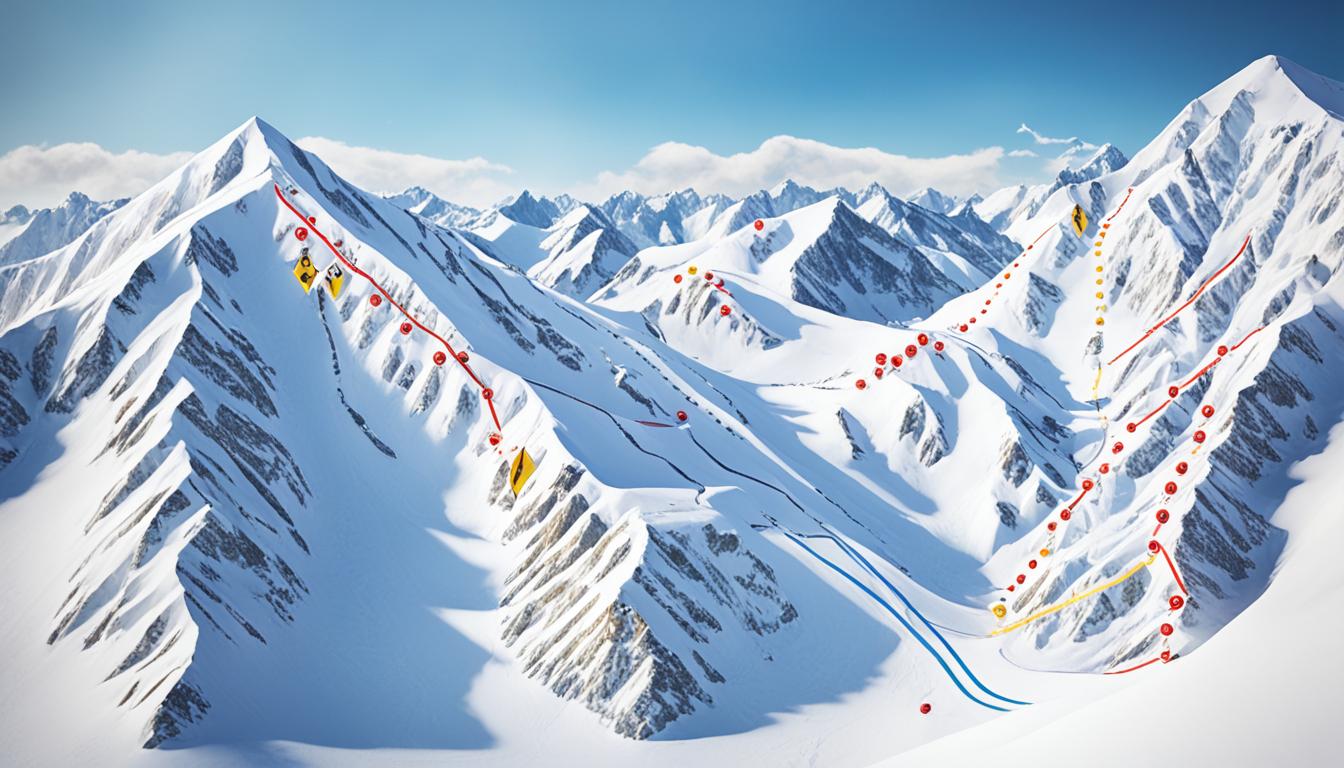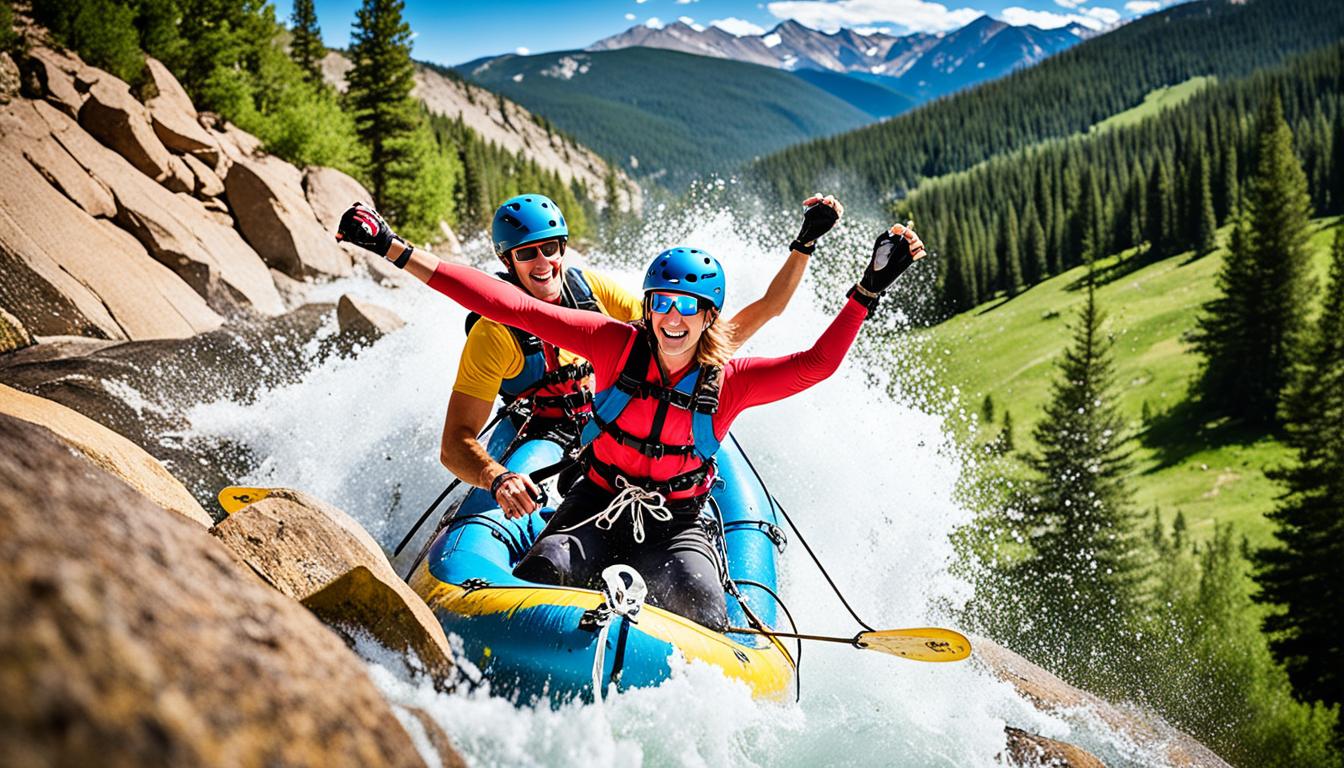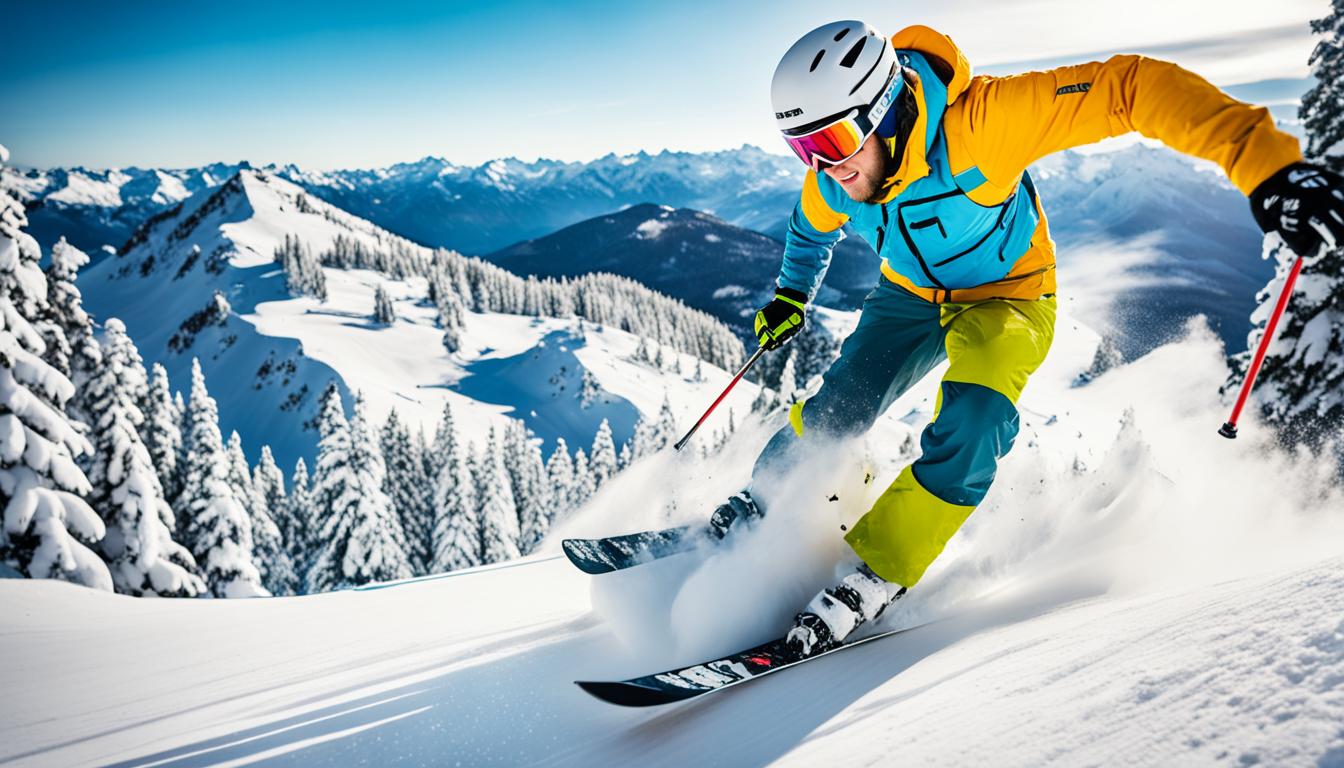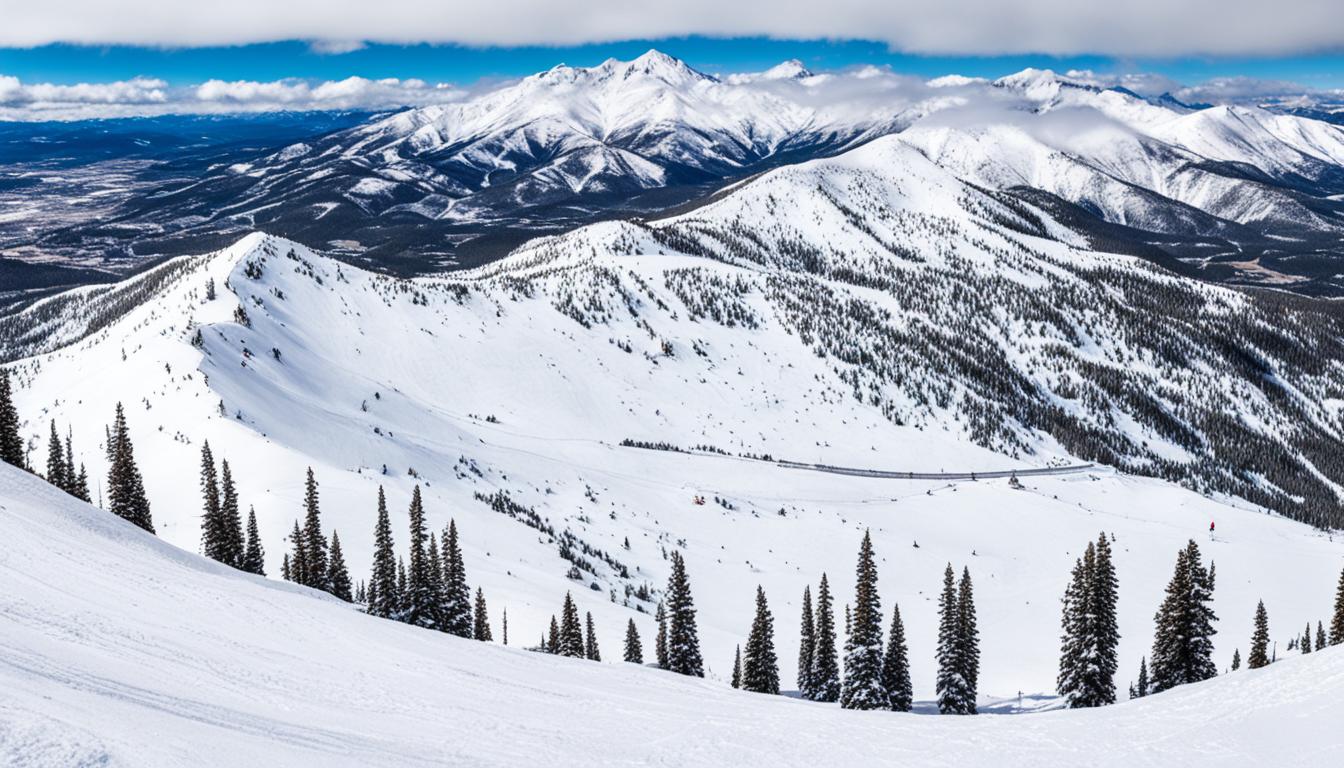Gearing up for a thrilling winter sports adventure? Exciting as it may be, it’s essential to prioritize safety when venturing into the mountains. Avalanche risks are a real concern that all winter sports enthusiasts must be aware of and prepare for.
Colorado’s majestic mountains offer breathtaking slopes for skiing, snowboarding, hiking, and snowmobiling. However, they also harbor the potential for thousands of avalanches each winter, posing serious risks to outdoor enthusiasts.
Did you know that on average, 6 people lose their lives to avalanches in Colorado every year? These unsettling statistics highlight the importance of understanding and mitigating avalanche risks.
Key Takeaways:
- Stay informed about avalanche forecasts and current weather conditions before heading out.
- Avoid venturing into avalanche-prone areas without checking the latest avalanche advisory.
- Stick to the boundaries of reputable commercial ski areas for reduced avalanche danger.
- Travel with a group and ensure everyone carries avalanche rescue equipment.
- Wait at least 36 hours after a significant snowstorm to allow the snow to stabilize.
By understanding avalanche risks by season and adopting proper safety measures, we can make the most of our winter sports adventures while minimizing the dangers associated with avalanches.
Avalanche Risk Factors to Consider.
When it comes to venturing into avalanche-prone areas, understanding the risk factors involved is crucial for your safety. By being aware of these factors and taking appropriate precautions, you can significantly reduce the chances of an avalanche accident.
Familiarize Yourself with the Terrain
Ascents in gullies, couloirs, or large faces that are exposed to avalanches pose a higher risk. Additionally, approaches through terrain traps with overhead avalanche terrain can increase the danger. It is important to recognize and acknowledge when the chosen route travels in “complex” terrain, characterized by exposure to multiple avalanche paths and glaciation.
“Planning a safe climb involves identifying areas of exposure on the chosen route and linking the prevailing conditions and forecast to assess the likelihood of avalanche activity.”
Consider Route Variations
Even if you have successfully ascended a particular route before, descents via a different route where conditions are substantially different can contribute to avalanche danger. Always evaluate the snowpack stability and prevailing conditions when deciding on your descent route.
Stay Informed with Avalanche Forecasts
Avalanche forecasts and current weather conditions play a crucial role in determining the possibility of avalanches. Keeping up-to-date with avalanche forecasts in your area is essential for making informed decisions about your climbing or skiing plans. Additionally, ensure you are knowledgeable about snowpack stability assessment techniques, such as understanding the snowpack layers and the signs of instability.
| Avalanche Risk Factors | Description |
|---|---|
| Ascents in exposed areas | Routes in gullies, couloirs, or large exposed faces increase the risk of avalanche accidents. |
| Approaches through terrain traps | Terrain traps with overhead avalanche terrain can amplify the dangers of avalanches. |
| Complex terrain | Routes that traverse complex terrain, characterized by exposure to multiple avalanche paths and glaciation, pose greater risk. |
| Variations in routes | Choosing descents via a different route where conditions differ significantly can contribute to avalanche danger. |
By understanding these avalanche risk factors and being equipped with the knowledge of snowpack stability assessment and avalanche terrain awareness, you can make informed decisions that prioritize your safety in avalanche-prone areas.
Snowpack Stability Assessment and Forecasting.
Snowpack stability assessment and forecasting are crucial for understanding avalanche risks by season. By evaluating the condition of the snowpack and analyzing weather data, we can make informed decisions to ensure our safety in avalanche-prone areas.
Avalanche forecasts provide valuable information about the hazard rating, recent events, and the overall state of the snowpack. They also highlight specific avalanche problems and identify the weather factors that contribute to avalanche danger.
The following weather conditions play a significant role in determining avalanche problems:
- Freezing level: The altitude where the temperature drops below freezing, affecting the stability of the snowpack.
- Precipitation totals: The amount of snowfall and rain that contributes to the accumulation and weight of the snowpack.
- Wind: The direction and intensity of wind can redistribute snow and create wind slabs, increasing the risk of avalanches.
Remote weather station telemetry provides real-time data about the snowpack, including recent snowfall and temperature variations. This information helps us assess the current stability of the snowpack and identify potential red flags.
When assessing the stability of the snowpack, it’s essential to monitor persistent weak layers, early warm-ups, temperatures above freezing, and large rainstorms. These factors can weaken the snowpack and increase the likelihood of triggering an avalanche.
To mitigate risks, it’s crucial to create time plans that estimate travel time and consider the current weather conditions. By avoiding hazardous conditions and choosing the right time to venture into avalanche-prone areas, we can minimize the potential for accidents.

Managing Avalanche Risks with Timing and Aspect.
When it comes to managing avalanche risks, two key factors come into play: timing and aspect. By understanding the nuances of these factors, we can make informed decisions to reduce the chances of accidents.
An overnight freeze and a crust formation on the surface of the snowpack create supportable conditions for travel in the morning. This solidification overnight provides stability, allowing for safer navigation through the terrain. It’s crucial to take advantage of these frozen surfaces while they last, especially in the early hours of the day.
Equally important is understanding the timing of sun exposure. As the sun rises and moves across the sky, it affects the different aspects of the slope. The aspect refers to the direction the slope faces in relation to the sun. Knowing which aspects receive direct sunlight at specific times is essential for choosing the right aspect to ski or climb.
Expert planners also consider the relief of the terrain to chase the softening snow throughout the day. Relief refers to the variation in elevation and steepness of the slope. By strategically planning a tour that starts on a northeast/east aspect, wraps around to south, and finishes on a west aspect, it’s possible to enjoy optimal snow conditions throughout the day while avoiding hazardous slopes.
Here’s a table highlighting the recommended aspects based on sun exposure throughout the day:
| Time | Aspect |
|---|---|
| Morning | Northeast/East |
| Noon | South |
| Afternoon | West |
In addition to timing and aspect, monitoring surface conditions is crucial for avoiding sun-exposed terrain when it becomes unstable. Keep an eye out for signs such as pinwheels, rollerballs, or loose wet avalanches. These are indications that the sun has had a significant impact on the stability of the snowpack, making it necessary to move away from sun-hit slopes.
By understanding the importance of timing and aspect in managing avalanche risks, we can make informed choices that enhance our safety in the backcountry. Remember, proper planning, observation, and adaptation are key to enjoying the winter wilderness while minimizing the potential dangers.
Conclusion
Ensuring winter sports safety requires a thorough understanding of avalanche risks by season. By carefully monitoring avalanche forecasts, assessing the stability of the snowpack, and considering prevailing weather conditions, we can mitigate the dangers associated with avalanches and enjoy our outdoor adventures with confidence.
Proper timing and choosing the right aspect of the mountain are crucial in managing avalanche risks. Taking advantage of an overnight freeze and crust can provide a supportive surface for travel, while understanding the sun’s exposure throughout the day allows us to plan our route wisely. By prioritizing relief and avoiding hazardous slopes, we can navigate changing conditions and minimize our exposure to avalanches.
Of course, it is essential to follow avalanche safety tips to ensure our winter sports activities remain safe. Staying informed about avalanche forecasts, carrying the necessary avalanche rescue equipment, and traveling with a group are critical precautions. By being prepared, making smart decisions, and prioritizing winter sports safety, we can fully enjoy our time in the mountains while minimizing the potential danger of avalanches.
Remember, a safe and enjoyable winter sports experience starts with understanding the risks and taking the necessary precautions. So let’s venture out, explore the wondrous winter landscapes, and create lasting memories, all while keeping our safety at the forefront of our minds.
FAQ
What is the risk of avalanches during the winter season?
Thousands of avalanches occur each winter in the mountains of Colorado, posing a risk to outdoor enthusiasts. On average, 6 people die in avalanches in the state of Colorado every year.
When do most avalanches occur?
Most avalanches occur during or just after snowstorms and on slopes of 30 to 45 degrees.
How long should I wait after a big snowstorm before venturing out?
Waiting 36 hours after a big snowstorm allows the snow to become more stable.
What can I do to minimize the risk of avalanches?
Staying in valleys away from avalanche chutes, dense trees, or gentle slopes can minimize avalanche risk. It is also safer to stay within the boundaries of commercial ski areas as they work to reduce avalanche danger.
What should I check before heading into avalanche-prone areas?
It is important to check avalanche forecasts and current weather conditions before venturing into avalanche-prone areas.
Is it safe to travel alone in avalanche-prone areas?
Traveling alone should be avoided, and it is recommended that all members of a party carry avalanche rescue equipment.
What factors increase the risk of avalanche accidents?
Ascents in gullies, couloirs, or large faces with exposure to avalanches, as well as approaches through terrain traps with overhead avalanche terrain, are common factors that increase the risk of avalanche accidents. Descents via a different route where conditions are substantially different can also contribute to avalanche danger.
How can I assess the stability of the snowpack?
Snowpack stability assessment involves monitoring persistent weak layers, early warm-ups, temperatures above freezing, and large rainstorms as red flags. Monitoring avalanche forecasts, weather conditions, and remote weather station telemetry can provide valuable data about the snowpack and recent snowfall.
What role do timing and aspect play in managing avalanche risks?
Timing and aspect are crucial in managing avalanche risks. An overnight freeze and a crust on the surface of the snowpack create supportable conditions for travel in the morning. Understanding the timing of sun exposure is essential for choosing the right aspect to ski or climb. Relief of the terrain should be considered to chase the softening snow throughout the day.
How can I ensure a safe winter sports experience?
By following proper avalanche safety tips, monitoring avalanche forecasts, assessing snowpack stability, and considering weather conditions, enthusiasts can enjoy outdoor activities while minimizing the danger of avalanches. Staying informed, being prepared, and making smart decisions are key to winter sports safety.




